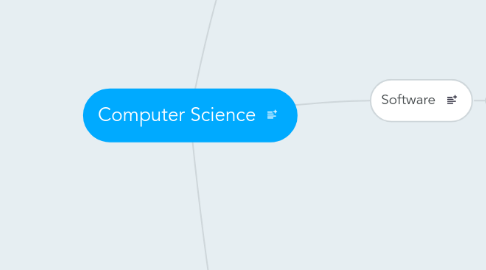
1. Hardware Engineering
1.1. Network
1.1.1. Design
1.1.2. Propgamming
1.1.2.1. Switch
1.1.2.2. Router
1.2. Main
1.2.1. Internal
1.2.1.1. Mothetrboard
1.2.1.2. powersupply
1.2.1.3. CD/DVD
1.2.1.4. Hard Disk
1.2.1.5. Farmware
1.2.2. External
2. Software
2.1. Software Development
2.1.1. Programming language
2.1.1.1. Web Based Language
2.1.1.1.1. Service Base
2.1.1.1.2. Application Base
2.1.1.2. Desktop Based Language
2.1.1.2.1. Service Base
2.1.1.2.2. Application Base
2.1.2. Software Project Management
2.1.2.1. Business Process Management
2.1.2.1.1. Management process
2.1.2.1.2. Operational Process
2.1.2.1.3. Support Process
2.1.2.2. Contract Management
2.1.2.3. Requirement Management
2.1.2.4. Quality Management
2.1.2.5. Risk Management
2.1.2.6. Schedule and Control Management
2.1.2.7. Development Management
2.1.2.7.1. Development Life Cycle Management
2.1.2.8. Software Life cycle management
2.1.3. Software Quality Assurance
2.1.3.1. Test case writer
2.1.3.2. Content Writer
2.1.3.3. Reliability Test
2.1.3.4. Efficiency Test
2.1.3.5. Maintainability Test
2.1.3.6. Security Test
2.1.3.6.1. Unit Test
2.1.3.6.2. Load test
2.1.3.6.3. Functionality Test
2.1.4. Software Quality Control
2.1.4.1. Version Management
2.1.4.2. Maintainability Management
2.1.5. Software Architect
2.1.6. Designing
2.2. Usages
2.2.1. Operating System
2.2.1.1. Server
2.2.1.1.1. Windows
2.2.1.1.2. Linux
2.2.1.2. Regular
2.2.1.2.1. Windows
2.2.1.2.2. Linux
2.2.1.2.3. Mac
2.2.2. Application Usages
2.2.2.1. Off Line
2.2.2.1.1. Office
2.2.2.1.2. Graphics
2.2.2.2. On Line
2.2.2.2.1. Communication
2.2.2.2.2. Social Media
2.2.2.2.3. e-commerce
3. Theoritical
3.1. Complexity
3.1.1. Analysis of Algorithm
3.1.1.1. Parameterized complexity
3.1.2. Computational Hardness Asumption
3.1.3. Computational Problem
3.1.3.1. Distributed computing problems
3.1.3.2. Satisfiability problems
3.1.4. Descriptive complexity
3.2. Evolutionary
3.2.1. Interactive Evolutionary Computation
3.2.1.1. Human-based genetic algorithm
3.2.1.2. Interactive evolutionary computation
3.2.1.3. NEAT Particles
3.2.2. Artificial Life
3.2.2.1. Artificial life models
3.2.2.2. Virtual babies
3.2.2.3. Virtual pets
3.2.3. Evolutionary Algorithm
3.2.3.1. Gene expression programming
3.2.3.2. Genetic algorithms
3.2.3.3. Genetic programming
3.2.3.4. Interactive evolutionary computation
3.3. Formal Language
3.3.1. Algorithms on string
3.3.1.1. Parsing algorithm
3.3.1.2. Sequence alignment algorithm
3.3.1.3. String matching algorithm
3.3.1.4. Substring indices
3.3.2. Formal Theories
3.3.2.1. Formal System
3.3.2.2. Formal theories of arithmetic
3.3.3. Logic Symble
3.3.3.1. Logic symbol templates
3.3.3.2. Logical connectives
3.3.3.3. Logical expressions
3.3.4. Pattern Matching
3.3.4.1. Pattern matching programming languages
3.3.4.2. Permutation patterns
3.3.4.3. Phonetic algorithms
3.3.4.4. Regular expressions
3.3.4.5. String Matching Algorithm
3.3.5. Parsing
3.3.5.1. Parsing algorithms
3.3.5.2. Natural language parsing
3.3.5.3. Parser generators
3.4. Information Theory
3.4.1. Algorithmic information Theory
3.4.1.1. Algorithmic Probability
3.4.1.2. Binary Combanitary Logic
3.4.1.3. Binary lambda calculus
3.4.1.4. Computational indistinguishability
3.4.2. Coding Theory
3.4.2.1. Character Encoding
3.4.2.2. Neural Coding
3.4.3. Data Compression
3.4.3.1. Image compression
3.4.3.2. Data Compression
3.4.3.3. Video Compression
3.4.3.4. Archive Fomats
3.4.3.4.1. Disk Images
3.4.3.4.2. Web Archieve
3.4.3.5. Compression File System
3.4.4. Data Differencing
3.4.4.1. File Comparison
3.4.5. Detection Theory
3.4.5.1. Location estimation in sensor networks
3.4.5.2. Minimax
3.4.6. Unit of information
3.4.6.1. Data Unit
3.4.7. Network Theories
3.4.7.1. Forward Theories
3.4.7.2. Queueing theory
3.4.7.3. Reverse proxy
3.4.7.4. WAN optimization
3.5. Natural Computation
3.5.1. Natural computing
3.5.2. Bio inspired computing
3.6. Unsolved Problems in computer science
3.6.1. One way function
3.6.2. K- Server Problem
3.6.3. Computational complexity in Matrix multiplication
3.6.4. Discrete logarithm
3.6.5. Unique games conjecture
3.6.6. Integer factorization
3.7. Theoretical computer science conferences
3.8. Theory of Computation
3.8.1. Turing Machine
3.8.1.1. Crossing sequence
3.8.1.2. Quantum Turing machine
3.8.1.3. Turing switch
3.8.1.4. Probabilistic Turing machine
3.8.2. Recursion
3.8.2.1. Fixed points
3.8.2.2. Mathematical induction
3.8.2.3. Recurrence relations
3.8.2.4. Recursion schemes
3.8.3. Model of Computation
3.8.3.1. Abstract machines
3.8.3.2. Applicative computing systems
3.8.3.3. Stack machines
3.8.3.4. Persistence
3.8.3.5. Educational abstract machines
3.8.4. Computer Arithmatic
3.8.4.1. Adders
3.8.4.2. Binary arithmetic
3.8.4.2.1. Binary Logic
3.8.4.2.2. Bit Data Structure
3.8.4.2.3. Boolean Algebra
3.8.4.3. Computer arithmetic algorithms
3.8.4.4. Data Unit
3.8.5. Automata
3.8.5.1. Cellular Automata
3.9. Database
3.9.1. Relational Database
3.9.1.1. Database Algorithm
3.9.1.1.1. Join algorithms
3.9.1.2. Database constraints
3.9.1.2.1. Database normalization
3.9.1.2.2. Dependency theory
3.9.1.2.3. Functional dependency
3.9.1.2.4. Lossless-Join Decomposition
3.9.1.2.5. Multivalued dependency
3.9.1.2.6. Transitive dependency
3.9.1.3. Database models
3.9.1.3.1. Entity Relationship Model
3.9.1.3.2. Relational Model
3.9.1.4. Database normalization
3.9.2. Data Mining
3.10. Mathematical Foundation
3.10.1. Mathematics of Computing
3.10.1.1. Logic in computer Science
3.10.1.2. Numerical Analysis
3.10.2. Game Theory
3.10.3. Graph Theory
3.11. Artificial Intelligence
3.11.1. Automated Reasoning
3.11.2. Computer vision
3.11.3. Natural language processing
3.11.4. Machine Learning
3.11.5. Robotics
